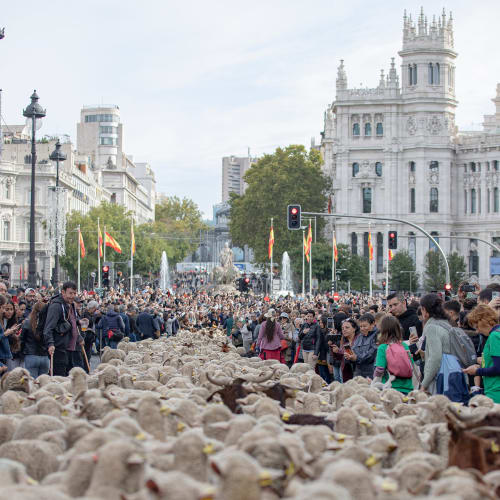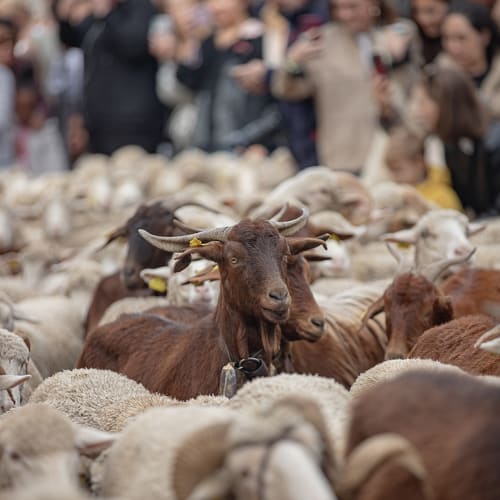Ancient Traditions: Sheep Fill the Streets of Madrid
Jonathan Harris | October 2025




Bleating sheep and clanging bells replace the roar of traffic every October in Madrid. A bearded shepherd in medieval dress and wooden clogs whistles to his dogs to keep the herd on the street and out of the high-end shops and restaurants to the left and right.
Madrid is on the route of the trashumancia, the ancient migration of livestock from the fields of Castilla y León in the north down to their winter grazing in sun-drenched Andalucía in the south. It is a reminder of the rhythms of pastoral life that punctuated Spain’s culture until not too long ago.
In the Middle Ages, the soft wool of the Merino sheep was the source of much of Spain’s wealth. The wool trade was so valuable that the trashumancia migration was given the right of way through villages, towns and even cities. There were dozens of routes across almost every region of the country.
When our father, Don Harris, first visited Spain in the 1960s, he delighted in the living history he observed in the countrysides of Galicia, Andalucía and Castilla y León. He told me of meeting a farmer who covered the heads of his oxen with rabbit pelts to protect them from the sun while they plowed the fields. He showed us photos of farmers threshing their wheat with ingeniously hinged sticks, and tossing the chaff into the air with pitchforks made from sapling trees carefully grown so that their branches could be formed into tines.
As much as this rustic way of life delighted him as a visitor, Don always acknowledged that it was a hard way to live. And he was excited and proud of the Spanish people when they transitioned to democracy and opened to the world in the 1970s and 1980s. In more recent years, he was astonished at the prosperity and modernity that had arrived, from lightning-fast trains to modern gastro markets like Mercado de San Miguel in Madrid.
The trashumancia in Madrid is an example of the massive changes that Spain has experienced. In fact, the tradition had all but died in the 20th century as cars and trucks barreling down asphalt streets replaced cobblestone and earth paths across the region.
In 1994, the people of Madrid realized that they had lost part of their history and culture. They inaugurated an annual Fiesta de la Trashumancia, after the Spanish parliament acknowledged the traditional routes used to herd livestock through the city.
Every October, the shepherds drive their sheep to city hall. There they pay the mayor 50 maravedís al millar, or 50 coins per thousand head, which was the payment established in 1418 for crossing the city.
Nowadays Spain’s pastoral traditions are nearly gone. It is getting harder and harder to preserve some of the incredible food ways of the country. We have witnessed it ourselves as some of our artisan suppliers have struggled. Who wants to bend over and pick crocus flowers for saffron anymore? Who will tend to the cows and goats in the steep valleys where Cabrales is made?
Celebrating the ancient traditions of Spain is crucial to saving them from extinction. The boisterous Fiesta de la Trashumancia is one example, a way to remind us of the beautiful heritage that could be lost. And as a Spanish teenager looks up from his cellphone to witness a flock of sheep strolling through bustling Madrid, maybe it will inspire him to support these traditions - or even become a shepherd!

¡Hola! I'm Jonathan Harris, one of the owners of La Tienda. I love sharing insights about Spain's amazing food culture.
Learn more >

